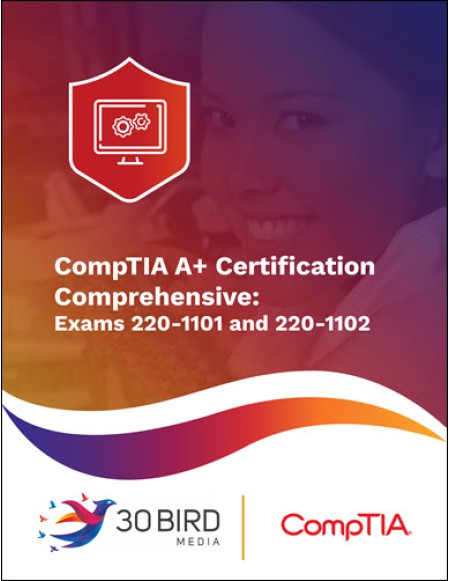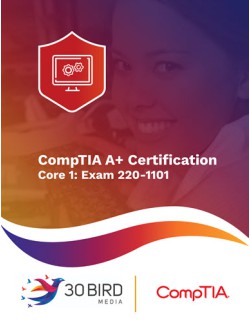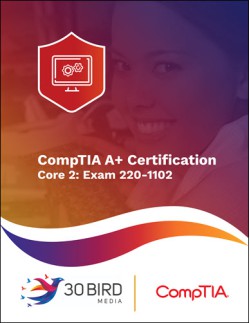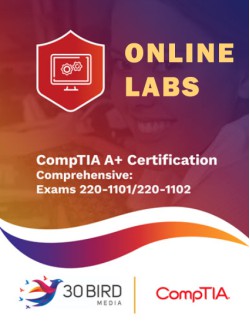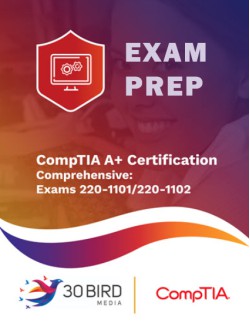Introduction
Course setup
A+ Certification skills inventory
Chapter 1: Troubleshooting
Module A: Troubleshooting theory
Module B: Safety
Module C: Environmental factors
Chapter 2: Motherboards and CPUs
Module A: Motherboards
Module B: CPUs
Chapter 3: Computer power supplies
Module A: Power supply connectors
Module B: Power supply installation
Module C: Power supply troubleshooting
Chapter 4: Memory
Module A: Read-only memory
Module B: Random access memory
Chapter 5: Computer expansion
Module A: Expansion interfaces
Module B: Expansion card installation
Module C: Connectors and cables
Chapter 6: Physical storage
Module A: Disk drives
Module B: RAID storage
Module C: Optical drives
Module D: Other storage methods
Chapter 7: Input-output devices
Module A: Input devices
Module B: Display output devices
Module C: Display management
Module D: Other input and output devices
Chapter 8: Printers and multi-function print devices
Module A: Printer technologies
Module B: Printer installation and maintenance
Module C: Printer troubleshooting
Chapter 9: Operating systems
Module A: Windows versions and features
Module B: Non-Windows operating systems
Module C: Operating system installation and upgrades
Module D: Applications and scripting
Chapter 10: Operating system management
Module A: Operating system features and tools
Module B: Control Panel utilities
Module C: Command-line utilities
Module D: Operating system troubleshooting
Chapter 11: Network basics
Module A: Classifying networks
Module B: Network devices
Module C: Internet connections
Chapter 12: Network cables and connectors
Module A: Twisted-pair connections
Module B: Coaxial connections
Module C: Optical media
Chapter 13: Network protocols
Module A: TCP/IP settings
Module B: Transport protocols
Module C: Application protocols
Chapter 14: Wireless networking
Module A: Wireless technology
Module B: Wi-Fi standards
Chapter 15: Windows networking
Module A: Network shares
Module B: Network connections
Module C: Connection troubleshooting
Chapter 16: Virtualization and cloud computing
Module A: Virtualization
Module B: Cloud computing
Chapter 17: Mobile devices
Module A: Mobile device types
Module B: Mobile device configuration
Module C: Mobile device troubleshooting
Chapter 18: Security principles
Module A: Threats and vulnerabilities
Module B: Security controls
Chapter 19: Security technologies
Module A: Operating system security
Module B: Security hardware and software
Chapter 20: Securing devices and data
Module A: Workstation security
Module B: Mobile device security
Module C: Security troubleshooting
Chapter 21: Securing networks
Module A: SOHO router features
Module B: Network security
Chapter 22: Operational procedures
Module A: Professionalism
Module B: IT operations
Module C: Incident response
Module D: Backup and recovery
Appendix A: Glossary
CompTIA A+ Certification Comprehensive: Exams 220-1101 and 220-1102 comes with lab exercises in the book. Complete classroom setup instructions are included in the book's Introduction.
Regarding the hardware components used in the labs: none are exotic, and most are found in a typical computer or computer toolkit. Ideally the instructor or training center would provide them for use during the class. Instructors don’t need to have absolutely all of them, especially for each student. It is more of a “wish list” for giving students a complete hands-on demonstration of all components discussed in the hardware portion of the course. If availability is a limitation for a specific component, instructors can demonstrate a single device for the entire class, or students can perform online research about common models and their features.
Customers can also choose to purchase Online Labs for the course. For the hardware labs, the online versions are simulations that take having actual hardware out of the picture. The online labs greatly simplify setup.
CompTIA A+ Certification Comprehensive: Exams 220-1101 and 220-1102 provides the basic knowledge needed to install, configure, and support computer software and implement networking. This includes:
- Applying basic methodical troubleshooting skills as an IT technician
- Identifying motherboard and CPU components, installing or replacing them, and troubleshooting their functions
- Identifying power supply functions and connectors, installing them into a PC, and troubleshooting power issues
- Configuring BIOS/UEFI firmware, identifying and installing RAM, and troubleshooting memory issues
- Comparing internal and external expansion buses on a computer, installing internal cards, and identifying expansion cables and connectors
- Distinguishing between physical storage technologies, installing drives, and troubleshooting storage problems
- Connecting, configuring, and troubleshooting common input-output devices
- Describing common printing technologies, installing and maintaining printers, and troubleshooting printing issues
- Identifying client operating system features, installing Windows and application software, and working with scripts
- Managing and troubleshooting operating systems using built-in administrative tools, such as the Windows Control Panel, Windows Settings, and command-line utilities
- Describing network principles, network devices, and internet connection technologies
- Identifying and categorizing network cables and connectors
- Configuring and troubleshooting issues related to TCP/IP and other network protocols
- Describing common wireless networking standards and encryption methods
- Configuring and troubleshooting problems with Windows resource sharing and network connections
- Identifying and using virtualization technology and cloud computing services
- Identifying types of mobile devices and operating systems, and configuring and troubleshooting mobile devices
- Recognizing common cybersecurity threats and the security controls which are used to reduce risk
- Identifying and using security features built into operating systems, as well as security hardware and software used on workstations and networks
- Securing workstations and mobile devices against security risks, and troubleshooting common security issues such as malware infection
- Applying best practices in IT operations, including policies, documentation, ticketing systems, incident response, and data backups and recovery
This course maps to the CompTIA A+ Certification 220-1101 and 220-1102 certification exams. You can download an objective map for the course from http://www.30bird.com.
This course assumes that you have basic computer knowledge.
Exam Prep and Online Labs available now!
For more information and access to the PowerPoint files, please e-mail sales@30bird.com.
To request the PowerPoints for this course, please e-mail sales@30bird.com.

